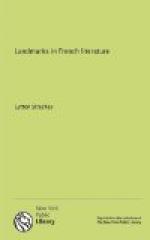Such were the surroundings among which the classical literature of France came into existence, and by which it was profoundly influenced in a multitude of ways. This literature was, in its form and its essence, aristocratic literature, though its writers were, almost without exception, middle-class men brought into prominence by the royal favour. The great dramatists and poets and prose-writers of the epoch were in the position of artists working by special permission for the benefit and pleasure of a select public to which they themselves had no claim to belong. They were in the world of high birth and splendid manners, but they were not of it; and thus it happened that their creations, while reflecting what was finest in the social ideals of the time, escaped the worst faults of the literary productions of persons of rank—superficiality and amateurishness. The literature of that age was, in fact, remarkable to an extraordinary degree for precisely contrary qualities—for the solidity of its psychological foundations and for the supreme excellence of its craftsmanship. It was the work of profound and subtle artists writing for a small, leisured, distinguished, and critical audience, while retaining the larger outlook and sense of proportion which had come to them from their own experience of life.
The fact, too, that this aristocratic audience was no longer concerned with the activities of political power, exercised a further influence upon the writers of the age. The old interests of aristocracy—the romance of action, the exalted passions of chivalry and war—faded into the background, and their place was taken by the refined and intimate pursuits of peace and civilization. The exquisite letters of Madame de Sevigne show us society assuming its modern complexion, women becoming the arbiters of taste and fashion, and drawing-rooms the centre of life. These tendencies were reflected in literature; and Corneille’s tragedies of power were replaced by Racine’s tragedies of the heart. Nor




